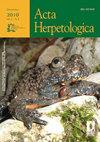新出现的病原体蝾螈(Bsal)对意大利野生蝾螈种群的威胁
IF 0.9
4区 生物学
Q4 ZOOLOGY
引用次数: 0
摘要
最近从亚洲引进的杀死蝾螈的真菌Batrachochytrium salandrivorans(Bsal)正在威胁欧洲不同地区的蝾螈种群。事实上,这种病原体正在中欧迅速传播,并已被引入西班牙东北部。特别令人担忧的是那些蝾螈多样性极高的地区,如意大利,那里有19种蝾螈,其中大多数是严格的地方性物种。在这项研究中,我们通过添加来自两个假定爆发地的样本,一个在撒丁岛,另一个在意大利大陆(利古里亚),更新了意大利野生蝾螈中Bsal存在的信息。此外,根据文献,我们在实验室实验感染试验的基础上,或从系统发育上最近的物种的易感性测试中,审查了所有意大利蝾螈物种的潜在易感性。总体而言,通过定量分子方法分析了在两个假定的Bsal爆发点采集的来自三个物种(沙氏Speleomantes sarrabusensis、strinatii Speleomattes和萨拉曼德拉蝾螈)的15份皮肤拭子,但没有一份结果呈阳性。大多数意大利蝾螈和几乎所有的地方性蝾螈都表现出对Bsal感染的高度易感性。因此,即使Bsal在意大利蝾螈种群中的存在尚未得到证实,整个蝾螈动物群也受到高度威胁,应采取预防性管理措施。再次强调,有必要对圈养或野生两栖动物的国际贸易制定严格的生物安全议定书,并在实地活动期间实施预防措施,以限制Bsal病原体的引入和传播。本文章由计算机程序翻译,如有差异,请以英文原文为准。
Threats of the emerging pathogen Batrachochytrium salamandrivorans (Bsal) to Italian wild salamander populations
The salamander killing fungus Batrachochytrium salamandrivorans (Bsal), recently introduced from Asia, is threatening salamander populations in different parts of Europe. In fact, this pathogen is rapidly spreading in Central Europe and has been also introduced into NE Spain. Of special concern are those regions with an exceptionally high salamander diversity such as Italy, where 19 salamander species are present most of which are strictly endemic. In this study, we update the information on the presence of Bsal in Italian wild salamanders, by adding samples from two presumptive outbreak sites, one on the island of Sardinia and one on continental Italy (Liguria). In addition, we reviewed the potential susceptibility of all the Italian salamander species on the basis of laboratory experimental infection trials, or from the tested susceptibility of the phylogenetically nearest species, according to the literature. Overall, 15 skin swabs from three species (Speleomantes sarrabusensis, Speleomantes strinatii and Salamandra salamandra) collected in the two presumptive Bsal outbreak sites were analysed by quantitative molecular methods, but none gave positive results. The majority of Italian salamander species and almost all of the endemic ones showed a high susceptibility to Bsal infection. Therefore, even if the presence of Bsal in Italian salamander populations has not been proven yet, the entire salamander fauna is highly threatened and preventive management actions should be taken. The need for strict biosecurity protocols on the international trade of captive or wild amphibians and for the implementation of preventive measures during field activities to limit the introduction and spread of the Bsal pathogen is again stressed.
求助全文
通过发布文献求助,成功后即可免费获取论文全文。
去求助
来源期刊

Acta Herpetologica
ZOOLOGY-
CiteScore
1.20
自引率
12.50%
发文量
10
审稿时长
6 months
期刊介绍:
Acta Herpetologica, a journal open to academics all over the world, offers itself as a new site for the presentation and discussion of the most recent results in the field of research on Amphibians and Reptiles, both living and extinct. The official journal of the Societas Herpetologica Italica (S.H.I.), Acta Herpetologica publishes original works – extended articles, short notes and book reviews – mostly in English, dealing with the biology and diversity of Amphibians and Reptiles.
 求助内容:
求助内容: 应助结果提醒方式:
应助结果提醒方式:


